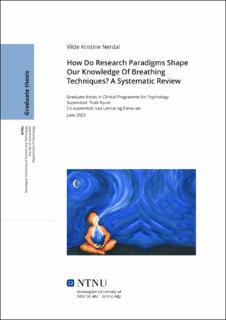| dc.description.abstract | Objective: Much evidence implies breathing techniques to have positive health effects. However, our current understanding of these practises is somewhat fragmented, as different breathing techniques are approached by various theories and research paradigms. In this review, studies originating from two different approaches will be compared. Research on slow breathing techniques (SBT) will represent the positivistic paradigm, while “Holotropic Breathwork” (HB) will typify the phenomenological paradigm. The aim is to examine how the unalike approaches influence our knowledge of these practises.
Method: Systematic searches of PubMed and PsychINFO, using search words related to cardiorespiratory outcomes, central nervous system outcomes and psychological outcomes, were conducted for SBT and for HB. The present review followed the Preferred Reporting Items for Systematic Review and Meta-Analyses (PRISMA) Guidelines.
Results: From a pool of 839 abstracts, 15 papers (SBT: 9, HB: 6) met the inclusion criteria. The two research bases differed in quantity, methodological quality and in what outcomes were measured. SBT papers had extensive assessments of cardiorespiratory and cortical outcomes. These studies focused less on psychological outcomes, and mainly assessed relaxation, negative and positive emotions. Conversely, HB papers measured phenomenological experiences to a large extend. Alterations of consciousness, perception and emotions were measured, as well as long-term outcomes of change in personality, purpose in life and spirituality. None of the HB papers measured biological outcomes. Methodological quality in SBT papers were superior to HB papers in both quantity and methodological quality.
Conclusion: The findings suggest the research paradigms to generate specific strengths and weaknesses in the knowledgebase on each technique. The main issue was that each approach seemed to favour certain outcomes, while neglecting others. Further, the variance in methodological traditions appears to accumulate reliable evidence on SBT, while results in HB papers are left more disputable. In sum, the difference between research paradigms could retain a fragmented knowledgebase, and valuable data could be overlooked. Future studies on breathing techniques ensure adequate methodological quality regardless of paradigmatic origin and adopt a more integrative approach when assessing outcomes. | |
